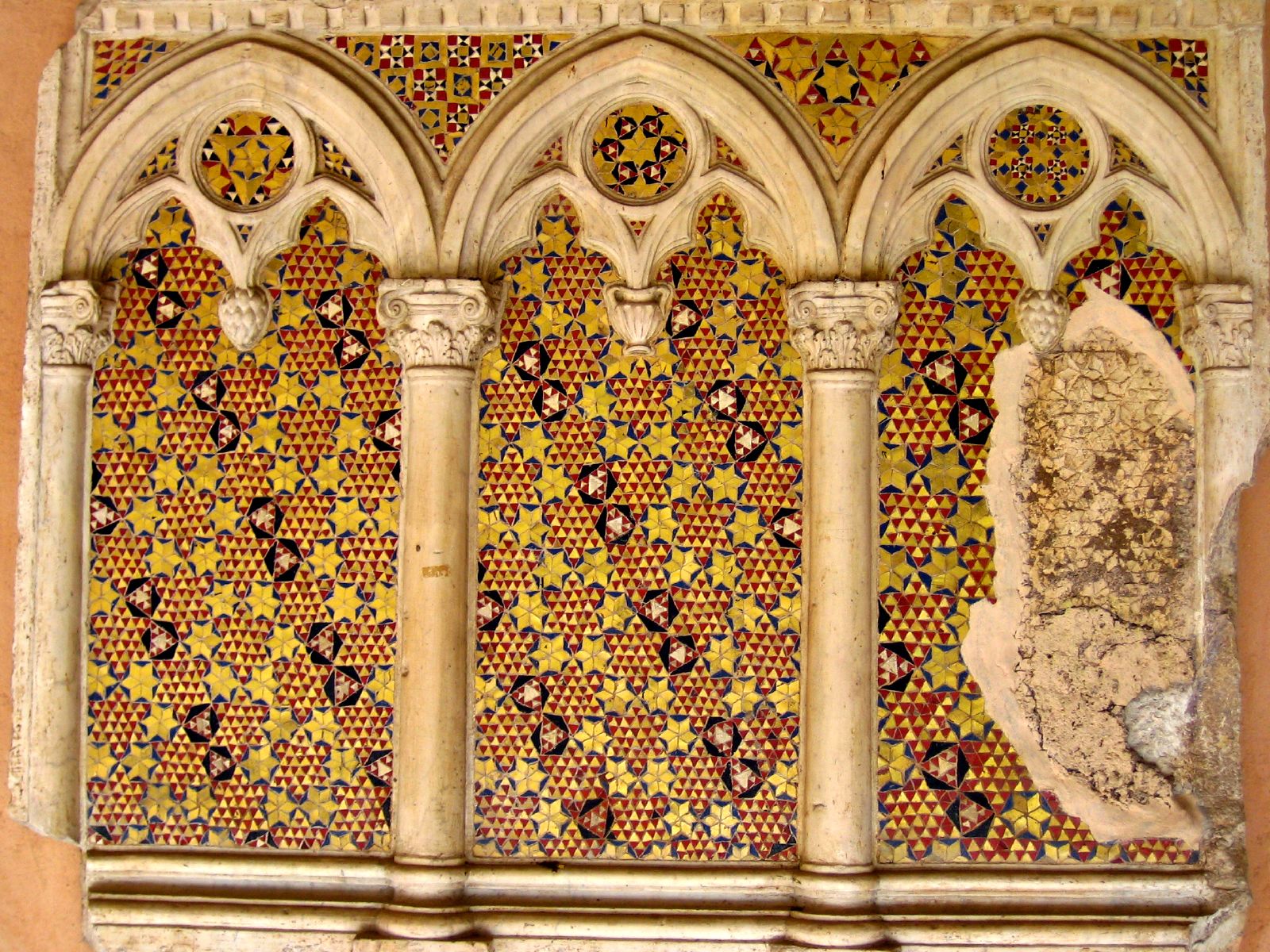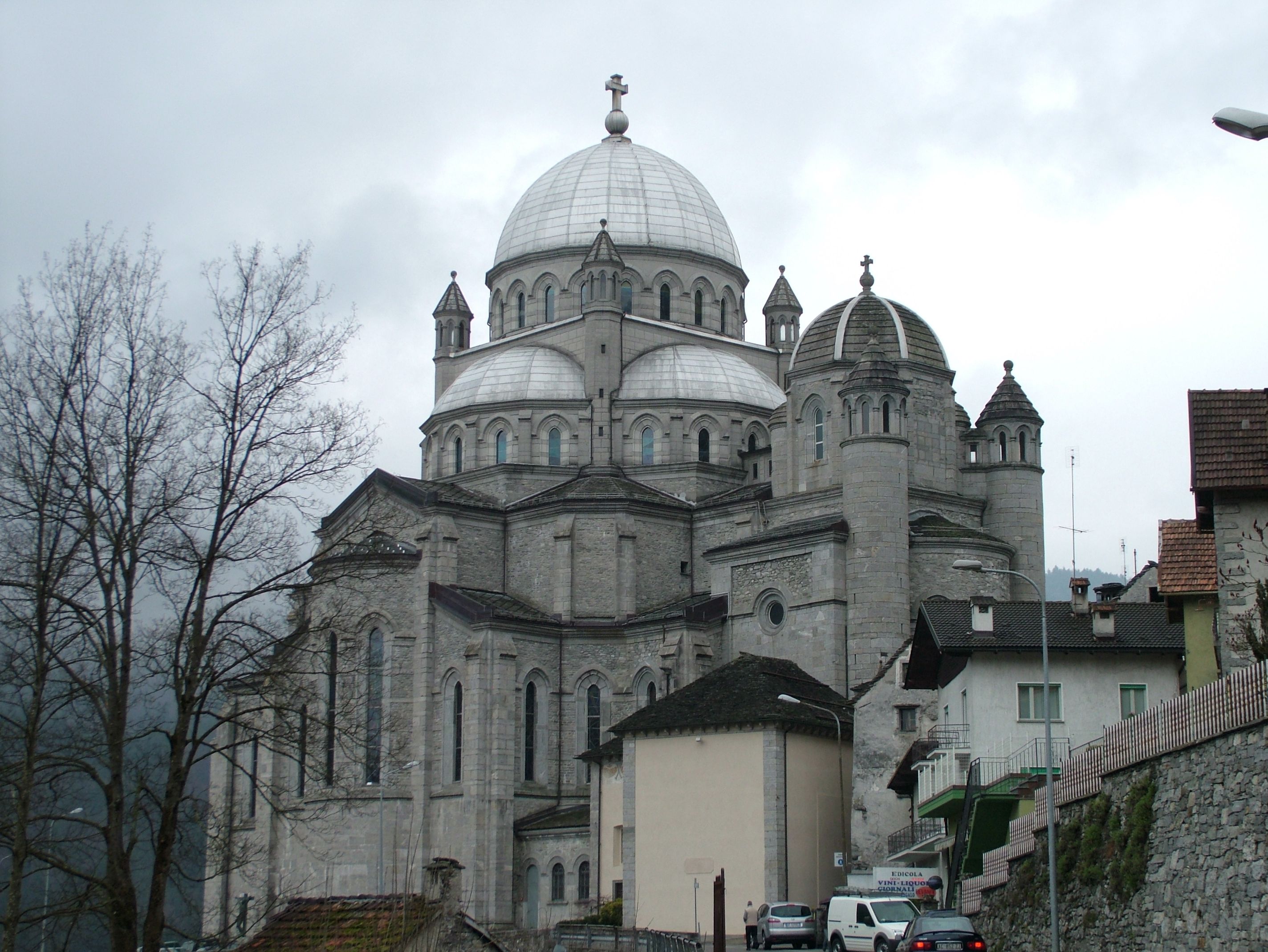|
Edoardo Collamarini
Edoardo Collamarini (1863–1928) was an Italian architect, active mainly in Bologna, region of Emilia Romagna, Italy. He was born and died in Bologna. He studied there and in Parma. He was friend of Giosuè Carducci, and pupil of Alfonso Rubbiani. He designed a number of tombs in the Certosa of Bologna such as the Talon Chapel (1929). Among his main works is the Neo-Byzantine-style church of Sacro Cuore di Gesù (1912). This style is also reflected in his Santuario della Madonna del Sangue at Re, completed only by 1928. Prince Alfonso Doria Pamphilj commissioned from him in 1890 the design of the Doria chapel (1897–1902) at the Villa Pamphilj in Rome, with Romanesque and Cosmatesque elements. He also designed the Palace of the Banca Popolare di Pesaro, the facade of the Sanctuary of Monticino at Brisighella, the Pavilion of Emiliano-Romagnolo for the 1911 Artistic Exposition of Rome. He worked on the refurbishment of Santo Stefano (1911–1925). In 1925, he helped refurbish ... [...More Info...] [...Related Items...] OR: [Wikipedia] [Google] [Baidu] |
Bologna
Bologna (, , ; egl, label= Emilian, Bulåggna ; lat, Bononia) is the capital and largest city of the Emilia-Romagna region in Northern Italy. It is the seventh most populous city in Italy with about 400,000 inhabitants and 150 different nationalities. Its metropolitan area is home to more than 1,000,000 people. It is known as the Fat City for its rich cuisine, and the Red City for its Spanish-style red tiled rooftops and, more recently, its leftist politics. It is also called the Learned City because it is home to the oldest university in the world. Originally Etruscan, the city has been an important urban center for centuries, first under the Etruscans (who called it ''Felsina''), then under the Celts as ''Bona'', later under the Romans (''Bonōnia''), then again in the Middle Ages, as a free municipality and later ''signoria'', when it was among the largest European cities by population. Famous for its towers, churches and lengthy porticoes, Bologna has a well-preserved ... [...More Info...] [...Related Items...] OR: [Wikipedia] [Google] [Baidu] |
Cosmatesque
Cosmatesque, or Cosmati, is a style of geometric decorative inlay stonework typical of the architecture of Medieval Italy, and especially of Rome and its surroundings. It was used most extensively for the decoration of church floors, but was also used to decorate church walls, pulpits, and Cathedra, bishop's thrones. The name derives from the Cosmati, the leading family workshop of craftsmen in Rome who created such geometrical marble decorations. The style spread across Europe, where it was used in the most prestigious churches; the high altar of Westminster Abbey, for example, is decorated with a Cosmatesque marble floor. Description and early history The Cosmatesque style takes its name from the family of the Cosmati, which flourished in Rome during the twelfth and thirteenth centuries and practiced the art of mosaic. The Cosmati's work is peculiar in that it consists of glass mosaic in combination with marble. At times it is inlaid on the white marble architraves of doors, on t ... [...More Info...] [...Related Items...] OR: [Wikipedia] [Google] [Baidu] |
Architects From Bologna
An architect is a person who plans, designs and oversees the construction of buildings. To practice architecture means to provide services in connection with the design of buildings and the space within the site surrounding the buildings that have human occupancy or use as their principal purpose. Etymologically, the term architect derives from the Latin ''architectus'', which derives from the Greek (''arkhi-'', chief + ''tekton'', builder), i.e., chief builder. The professional requirements for architects vary from place to place. An architect's decisions affect public safety, and thus the architect must undergo specialized training consisting of advanced education and a ''practicum'' (or internship) for practical experience to earn a license to practice architecture. Practical, technical, and academic requirements for becoming an architect vary by jurisdiction, though the formal study of architecture in academic institutions has played a pivotal role in the development of the ... [...More Info...] [...Related Items...] OR: [Wikipedia] [Google] [Baidu] |
19th-century Italian Architects
The 19th (nineteenth) century began on 1 January 1801 (Roman numerals, MDCCCI), and ended on 31 December 1900 (Roman numerals, MCM). The 19th century was the ninth century of the 2nd millennium. The 19th century was characterized by vast social upheaval. Slavery was abolitionism, abolished in much of Europe and the Americas. The Industrial Revolution, First Industrial Revolution, though it began in the late 18th century, expanding beyond its British homeland for the first time during this century, particularly remaking the economies and societies of the Low Countries, the Rhineland, Northern Italy, and the Northeastern United States. A few decades later, the Second Industrial Revolution led to ever more massive urbanization and much higher levels of productivity, profit, and prosperity, a pattern that continued into the 20th century. The Gunpowder empires, Islamic gunpowder empires fell into decline and European imperialism brought much of South Asia, Southeast Asia, and almost ... [...More Info...] [...Related Items...] OR: [Wikipedia] [Google] [Baidu] |
San Giovanni Battista Di Calamosco
San Giovanni Battista di Calamosco is a Roman Catholic parish church located on via Chiesa Calamosco #2 in the San Donato Quarter of Bologna, region of Emilia Romagna, Italy. History The parish is mentioned since 1088, while a church is documented since 1269. The present church was erected in 1729–30 by designs of Antonio Gamberini. It was refurbished in 1925 by Edoardo Collamarini. The baroque interior has seven side altars. The main altarpiece is a ''Birth of St John the Baptist'' attributed to Marcantonio Franceschini. The second altar to the right has a canvas depicting ''St Antony of Padua''; the third a ''Madonna della Scodella'', a copy of a Correggio painting. The first altar on the left has a stucco crucifix. The second altar to the left has a ''St Vincent Ferrer'' by Ubaldo Gandolfi Ubaldo Gandolfi (1728–1781) was an Italian painter of the late-Baroque period, mainly active in and near Bologna. Biography He was born in San Matteo della Decima and enrolled by ... [...More Info...] [...Related Items...] OR: [Wikipedia] [Google] [Baidu] |
Brisighella
Brisighella ( rgn, Brisighëla) is a ''comune'' (municipality) in the province of Ravenna, region of Emilia-Romagna, in Northeast Italy. Brisighella borders the following municipalities: Casola Valsenio, Castrocaro Terme e Terra del Sole, Faenza, Forlì, Marradi, Modigliana, Palazzuolo sul Senio, Riolo Terme. It originates from a '' rocca'' castle ordered by Maghinardo Pagani and later expanded by Francesco Manfredi, lord of Faenza. It is the birthplace of Dino Monduzzi (1922–2006), a cardinal of the Roman Catholic Church. The final part of the novel '' The Gadfly'' by Ethel Lilian Voynich (1897) is set in Brisighella. This historical novel, now neglected in England or in the US, almost unknown in Italy, was popular in the second half of the 20th century, on the basis of a Marxist reconsideration of its plot, in the USSR, Communist countries in Eastern Europe, Mao Zedong's China, etc. Main sights *Via del Borgo or Via degli Asini ("Donkeys' Road"), an elevated road mostly c ... [...More Info...] [...Related Items...] OR: [Wikipedia] [Google] [Baidu] |
Villa Doria Pamphili
The Villa Doria Pamphili is a seventeenth-century villa with what is today the largest landscaped public park in Rome, Italy. It is located in the quarter of Monteverde (Rome), Monteverde, on the ''Gianicolo'' (or the Roman Janiculum), just outside the Porta San Pancrazio in the ancient walls of Rome where the ancient road of the '' Via Aurelia'' commences. It began as a villa for the Pamphili family and when the line died out in the eighteenth century, it passed to Prince Giovanni Andrea IV Doria, and has been known as the Villa Doria Pamphili since. History Old villa The nucleus of the villa property, the ''Villa Vecchia'' or ‘old villa’, already existed before 1630, when it was bought by Pamfilio Pamfili, who had married the heiress Olimpia Maidalchini, to enjoy as a suburban villa. Thereafter he set about buying up neighbouring vineyards to accumulate a much larger holding, which was often known as the ''Bel Respiro'' or 'beautiful breath' as it stood on high ground, a ... [...More Info...] [...Related Items...] OR: [Wikipedia] [Google] [Baidu] |
Emilia Romagna
egl, Emigliàn (man) egl, Emiglièna (woman) rgn, Rumagnòl (man) rgn, Rumagnòla (woman) it, Emiliano (man) it, Emiliana (woman) or it, Romagnolo (man) it, Romagnola (woman) , population_note = , population_blank1_title = , population_blank1 = , demographics_type1 = , demographics1_footnotes = , demographics1_title1 = , demographics1_info1 = , demographics1_title2 = , demographics1_info2 = , demographics1_title3 = , demographics1_info3 = , timezone1 = CET , utc_offset1 = +1 , timezone1_DST = CEST , utc_offset1_DST = +2 , postal_code_type = , postal_code = , area_code_type = ISO 3166 code , area_code = IT-45 , blank_name_sec1 = GDP (nominal) , blank_info_sec1 ... [...More Info...] [...Related Items...] OR: [Wikipedia] [Google] [Baidu] |
Alfonso Doria Pamphilj
Alphons (Latinized ''Alphonsus'', ''Adelphonsus'', or ''Adefonsus'') is a male given name recorded from the 8th century (Alfonso I of Asturias, r. 739–757) in the Christian successor states of the Visigothic kingdom in the Iberian peninsula. In the later medieval period it became a standard name in the Hispanic and Portuguese royal families. It is derived from a Gothic name, or a conflation of several Gothic names; from ''*Aþalfuns'', composed of the elements ''aþal'' "noble" and ''funs'' "eager, brave, ready", and perhaps influenced by names such as ''*Alafuns'', ''*Adefuns'' and ''* Hildefuns''. It is recorded as ''Adefonsus'' in the 9th and 10th century, and as ''Adelfonsus'', ''Adelphonsus'' in the 10th to 11th. The reduced form ''Alfonso'' is recorded in the late 9th century, and the Portuguese form ''Afonso'' from the early 11th. and ''Anfós'' in Catalan from the 12th Century until the 15th. Variants of the name include: ''Alonso'' (Spanish), ''Alfonso'' (Spanis ... [...More Info...] [...Related Items...] OR: [Wikipedia] [Google] [Baidu] |
Santuario Della Madonna Del Sangue
The Santuario della Madonna del Sangue is a sanctuary in the ''comune'' (municipality) of Re, Italy. It is devoted to the Virgin Mary and it was built where in 1494 a miracle occurred: a small fresco of the ''Nursing Madonna'' was hit by a stone and started bleeding. This sanctuary is the destination of many pilgrimages from the area and is the most important religious place in Val Vigezzo. This church is part of the Via del Mercato, an itinerary of CoEur - In the heart of European paths. History and description Only many years after the miracle, in 1627, the bishop of Novara, Carlo Bascapè, inaugurated the first sanctuary, built thanks to his initiative. The basilica in Byzantine Revival architecture visible today was inaugurated on 5 August 1958. Designed by the architect Edoardo Collamarini, it has been built entirely by local masons and artisans and it was raised to the dignity of Minor basilica by Pope Pius XII Pope Pius XII ( it, Pio XII), born Eugenio Maria Gi ... [...More Info...] [...Related Items...] OR: [Wikipedia] [Google] [Baidu] |






